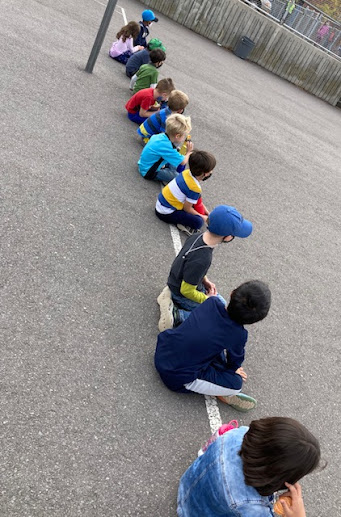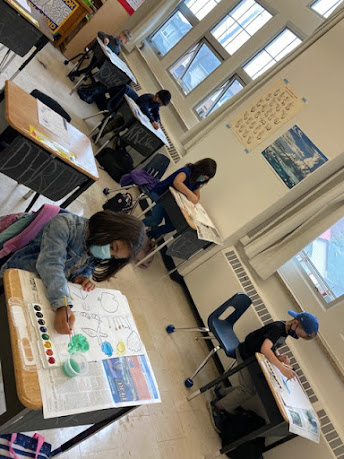Sunday, October 4, 2020
Phonics with Mrs. Farrelly
Update from Ms. R
News for October 2
Writing - The children have now reviewed how to write all the CAPITAL letters of the alphabet. The students practiced writing simple sentences with spaces between words and a period at the end of the sentence. The children are beginning to listen to the different sounds in one word (phonemic awareness). For example, the word "cat" is actually made up of 3 sounds (phonemes) "c - a - t". The class is starting to use what they know about letter sounds to help them with the phonetic spelling of unfamiliar words. For example, in the word "bird" there are the sounds "b - r - d". Of course the correct spelling is "bird", but for beginning writers, "brd" is an acceptable phonetic spelling of the word.
The children showed what they know about "concepts of print" by creating little blue books, with the spine on the left and the title and author name on the front cover. These books had content of the child's choosing and they were encouraged to write words and draw pictures inside.
Reading - The class has now learned all the letter names and letter sounds. The letter-sound connections are critical to both reading and writing. Along with this the children have learned the American Sign Language (ASL) signs for each letter. Please find a video of Mrs. Farrelly, our school principal, signing the alphabet letters and saying the letter name and the letter sounds in a separate posting.
The class read the little book "Jack" chorally as a class and listened for the starting sound of the words with a common rhyme: Jack, pack, back, quack.
Word Wall - The word wall words this week were: is, and, said,(bonus - please). The children are now on our classroom "Word Wall" and they are expected to read, use and write these words. Through the week the children practised using these words in sentences orally and they practised writing the words on worksheets and on their personal chalkboards.
Math - This week the class continued to practise orally counting from 1 up to 50. The goal is to have each child do this without looking at a 100 chart. The students also learned how to count backwards from 20 down to 1. Counting forwards is basically adding one (+1) each time and backwards is subtracting one (-1) each time. Being able to do this quickly and easily really helps with more formal adding and subtracting.
The children also learned the number words that go with numbers from one (1) to ten (10). In grade one, the students are required to be able to recognize and read these words.
The class learned how to represent numbers using "ten frames". A ten frame is a picture of ten squares arranged in two rows of five squares. They also used small, plastic cubes to show their understanding of a particular number. Using ten frames helps the beginning understanding of place value. For example, 14 can be seen as 4 more than ten, (which will later move to a place value understanding of 14 as one group of ten and 4 ones).
Oral Communication - The children are working on expressing themselves orally in group discussions. We had many great discussions this week. One discussion of note was when we talked about "left" and "right" and how to remember these concepts. We also did some action/dance work to help reinforce the ideas of left/right. We also had a wonderful class discussion around the four seasons of the year and how this pattern of fall/winter/spring/summer is repeated each year as the Earth makes its year-long trip around the sun.
The star students this week were: Barin, Cienna, Niall, Andy and Jaden.
Science - We had a great discussion of what the terms "living" and "non-living" mean. All things in our world can be sorted into these two groups. The children also talked about how living things can be sorted further into two groups, "plants" and "animals". Later in the week, the students looked at their watercolour paintings and sorted the images in their art into "living" and "non-living" things.
On Friday, the class talked about seeds. Seeds do not look like they are alive. The children looked closely at bean seeds and corn seeds (kernels). We created a chart to show what is the same and what is different about these two seeds. To prove that the seeds are actually alive, the students each set up an experiment to sprout the seeds. In a ziplock bag, each child put a piece of wet paper towel and the seeds. It will be interesting to see what happens!
Art - The children learned how to use a black "Sharpie" marker to define the images and designs in their drawings. They also learned the proper care and use of a permanent marker. The students were challenged to create an artwork that had both living and non-living things in it (as a connection to our science unit). The children also learn how to use watercolour paints to complete their art. This art along with the chart showing the sorting the words of their living and non-living images, is now on display in the hallway outside of our classroom.
Finally... on Friday, the class walked over the the BIG trees at the edge of the field outside. We talked about how the leaves of the trees were changing colour. We talked about which trees looked older and why. (They are taller and the trunk is bigger.) We measured around the trunk of a few trees and figured out that one big tree was about 93 years old and another was 88 years old. (We used the general rule of one year for every 2.5 cm of circumference.) One of the smaller trees was 10 years old. SO...their hypothesis of using height and trunk size as a measure of age was correct!
Books read aloud this week:
Squirrelly Gray by James Kolchalka
The Big Honey Hunt by Stan and Jan Berenstain
What Pet Should I Get? by Dr. Seuss
Tree - A Book About Seasons by Britta Teckentrup
If You Hold A Seed by Elly MacKay
VIDEOS of our read aloud books:
Squirrelly Gray - read aloud video
The Big Honey Hunt - read aloud video







